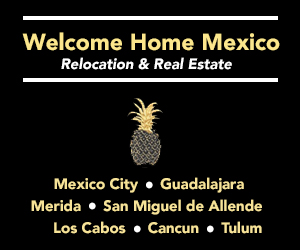Moving to Mexico: Buying Property in Mexico
Summary: Author Julie Doherty Meade covers a wide range of topics related to Buying Property in Mexico - from restricted zones to ejido land.
Buying a property in Mexico is more complicated than renting, but it can be an excellent investment -- especially if you plan to live in Mexico long-term. If you spend a little time checking out the market, acquainting yourself with the buying and selling process, and finding a good agent and notary, you will likely have a smooth and easy experience purchasing a property in Mexico.
That said, buying real estate in Mexico can be a minefield for uninformed newbies. Real estate transactions are complicated, official paperwork is written in Spanish, and the purchasing process includes steps that might not be familiar to American and Canadian buyers. In addition, brokers and real estate agents aren't legally licensed in Mexico, so the wrong real estate agent can lead you astray. Be careful, but also remember: Thousands of Americans, Canadians, and other foreign residents have successfully brought property in Mexico without incident.
The average price for a two-bedroom home in a nice neighborhood is around US $200,000, though costs vary tremendously by region and by the type of home you are buying. You can buy land for an average of US $50–75 per square meter, depending on the location of the property and the services available. Cost of land, too, varies widely by region and can be far pricier on the coasts.
Finding the Right Place
Once you have decided where in Mexico you want to live, you can start looking for the right home. Obviously, all the essential factors are in effect: budget, size, location, and investment potential. However, houses can be a bit different in Mexico (both in design and functionality), so it's worth taking the time to shop around.
In general, you will have a good experience buying property if you do your research, talk to people who have successfully purchased homes, work with a trusted broker, and shop around until you find the best deal. Ben Calderoni, a real estate agent for more than 30 years, has spent more than a decade representing buyers in San Miguel. He says the biggest mistake that new buyers make is "trusting their real estate agent without really checking out the market." It's worth the extra effort to follow Ben's advice and have a good look at what's available in your area. If budget is an issue, you may be able to save a few pesos by looking in more outlying neighborhoods, in smaller towns, or at properties that need some renovation. Many buyers also like the idea of purchasing a piece of land and building a house from the ground up. No matter what you choose, it's worth investing a little time and effort into the process.
Houses
You will find houses for sale by owner in any part of Mexico, with rather large and hopping real estate markets in Mexico City, Guadalajara, Puerto Vallarta, Cabo San Lucas, and other beach resorts. In most cases, the owner will list the property with a real estate company -- and sometimes with several (exclusive listings aren't particularly common in Mexico). Note that house listings may include patio and outdoor spaces as a part of the total square footage.
Typical Mexican houses are often a bit different than what you'd find in the United States and Canada. Even if they aren't historic, many houses take a cue from traditional Spanish design, with central patios or courtyards around which the rooms of the house are arranged. You may also notice that front yards are not particularly popular; residential streets are usually lined with tall and impenetrable walls. To see what a house is really like, you need to peek behind the doors. Often, you'll be surprised to see what's on the other side!
For many foreigners, the biggest difference in Mexican housing is the more fluid relationship between indoor and outdoor space. Because the climate is more generally agreeable in Mexico, many homes have drafty uncovered hallways, central patios, or even open-roof living areas. Many foreigners -- used to more control over the indoor climate -- feel the need to remodel houses with lots of outdoor area, sealing up the windows and hallways so they can run air-conditioning or heat.
Land
Buying land and building a home can be a good investment, as well as a rewarding experience. There are plenty of skilled architects, contractors, and builders who can help you realize your project, and building your own house gives you more control over the property and its design. It is, however, a more complicated process than buying a house directly.
You may be able to find an empty lot in the center of a city, but there are far more available in suburban neighborhoods and throughout Mexico's countryside. Some lots are sold as part of a general development, where each parcel is already equipped with electricity, water, sewer hookups, storm drains, and access to paved roads. If you are looking at lots outside a city, one of the primary considerations is its access to utilities like water and electricity, as well as access and maintenance of roads. Places off the beaten track may not have electrical hookups, and it may not be a quick or simple process to connect to the grid. If you do not have water on the land, it is possible to dig a well; however, the cost of a well is determined by how deep you have to dig. It can quickly add up if water is a long way down; do your research and consider the cost of installing utilities in the total cost of a property. At the same time, lots without utilities can be far cheaper, presenting an opportunity for those interested in building in an ecofriendly way. Just be ready for the challenge!
In addition to privately held land, Mexico has a system of ejidos, or communal land, that was established after the Revolution of 1910. Ejido land is not private property, but communally owned territory that is designated for use as residence, common land, and farmland. Until recently, ejido land could not be bought or sold. However, in 1992, during the presidency of Carlos Salinas, the New Farm Act discontinued the ejido system. Today, ejido land can be sold, but it must be converted to private property first. To do so, the entire community designated as "owner" must agree to the sale. If all owners are not notified, the sale could be annulled. For Mexican nationals, the buyer can become a member of the ejido, to whom the land will eventually be transferred when the property becomes regularized. For foreign nationals, it is necessary to find a prestanombre -- a Mexican national who will stand in for the buyer. The buyer, in the meantime, has no rights to the land. Ejido land is often far more inexpensive than private property, so some foreigners risk the investment. However, there is no entirely safe way to buy communal land without running the risk of losing control of the property. Anyone looking at ejidos should use caution and assume the associated risks. Lynn Rawden and her husband purchased ejido land on the coast of Oaxaca. She explains:
We have a presta nombre -- our friend in San Miguel offered to put the land in her name, and in return we are offering her a small portion of it. And the ability to visit our house (when we have one!) anytime she wants. It was ejido land, so our plot was cheap but well supervised by the community. It still is risky in the sense that we have heard several stories of nullified documents and debated land rights. But so far, we have been lucky. We have had to visit the site every year at least once, meet with the communitario [the community council] there, and maintain relations with them. We are expected to "improve" the land con- stantly, by clearing it, posting it, and putting up some basic structures. This ensures our ownership as well as signifies our dedication to the project, and most importantly employs the local people.
Resort Communities and Condominiums
Those looking to make a quick transition without worrying about remodeling, refitting, or building a new place can buy into a development. In many beach towns, as well as in colonial cities, there are large residential communities that are built and overseen by a single company. Many offer diverse living arrangements (with similar design), and some even provide furnishings in the total cost -- a good pick for those who don't want to go through the hassle of moving their household items.
Many developments offer the opportunity to invest in a condo before the development is complete. The rates for prepurchased houses may be signifi- cantly lower. These places may also have finance plans.
Restricted Zones
Foreign citizens are permitted to buy property anywhere in Mexico with the permission of the Mexican Foreign Affairs Ministry, with the exception of the restricted zones. When registering their purchase, foreigners must agree to adhere to Mexican law and waive any right to foreign intervention. When selling a property, foreigners are permitted to sell at a profit to either national or foreign buyers.
According to Mexican law, foreigners cannot buy a simple title for any property located within 100 kilometers of an international border or within 50 kilometers of the coast. However, there is a legal pathway through which foreigners can secure all rights of the owner, even in a restricted zone. In these cases, foreign- ers can establish a fideicomiso (trust) at a Mexican bank or credit union, and then purchase the property through the trust. The trust can be purchased for up to 50 years, with the option to renew when the original term is up. In this case, the beneficiary (or the foreigner) has all rights to the land -- including resale for profit.
From the book Moon Living Abroad in Mexico by Julie Doherty Meade. Excerpted by arrangement with Avalon Travel, a member of the Perseus Books Group. Copyright © 2012. For more information, visit http://www.moon.com.
About the Author
 Moon Living Abroad in Mexico author Julie Doherty Meade took her first trip to Mexico after college, and was immediately drawn to the country’s warm people and fascinating culture. For the next 10 years, she lived, worked, and traveled throughout Mexico before settling in San Miguel de Allende. She currently lives in Brooklyn with her husband, Arturo, and her transplanted chihuahua, Tequila.
Moon Living Abroad in Mexico author Julie Doherty Meade took her first trip to Mexico after college, and was immediately drawn to the country’s warm people and fascinating culture. For the next 10 years, she lived, worked, and traveled throughout Mexico before settling in San Miguel de Allende. She currently lives in Brooklyn with her husband, Arturo, and her transplanted chihuahua, Tequila.
Additional Information:
- Mexico Guide
- Healthcare & Health Insurance in Mexico
- Members Talk about Healthcare & Health Insurance in Mexico
- Best Places to Live in Mexico
- Real Estate in Mexico
- Guide to Real Estate in Mexico
- Pros & Cons of Living in Mexico
- Cost of Living in Mexico
- Cost of Living in Mexico
- Mexico Visa & Residency
- Is Mexico City Safe?
- 10 Best Places to Live in Mexico
- 2025 Guide to Living in Mexico
- Pros and Cons of Living in Mexico 2025
- 2025 Guide to Moving to Mexico
- Members Talk about the Cost of Living in Mexico
Comments
mightyhadley63I am considering moving to Mexico in the next year or so. I would like to purchase a plot of land. I am on social security disability and do not meet the income requirements to become a citizen. Is there anyway around this law? I want to move because of my health problems and because I am unable to live in the U.S. because of the high prices.
Rodrigo1974don't do it, unless it's a condo in a gringo friendly area, like cabo san lucas, Puerto Vallarta, alcupulco, or cancun. otherwise, just rent. you can get a great 2 bedroom apartment for $300 USD a month.





